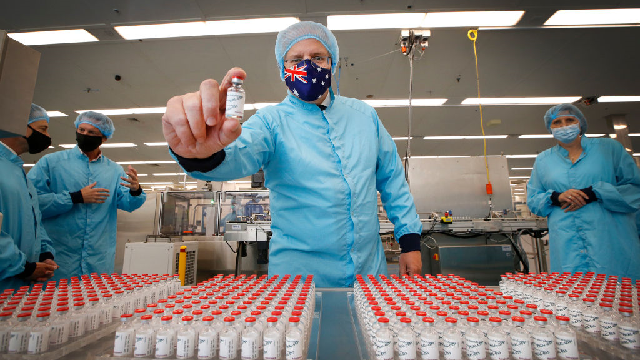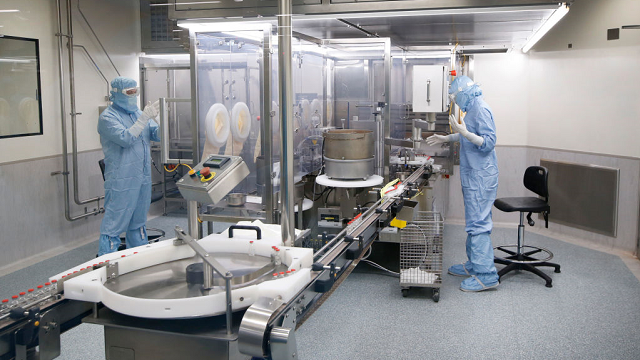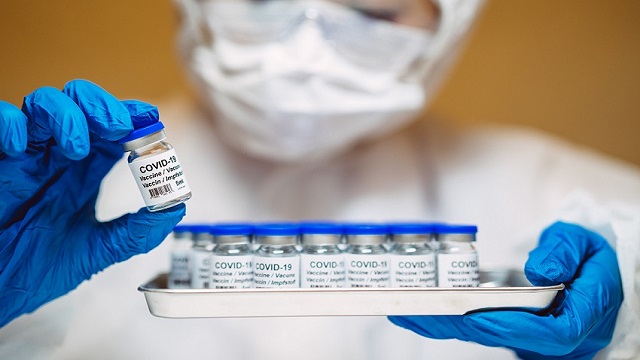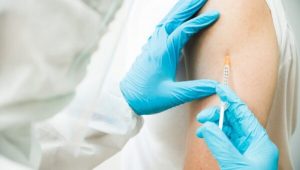Inside the Australian manufacturing process of the Oxford-AstraZeneca vaccine.
This resource is best suited to Chemistry and Biology students in Years 8, 9 and 10 who are learning about cells and chemical reactions. It details the steps involved in manufacturing a COVID-19 vaccine and shows an excellent real-world application of this scientific understanding.
Word Count: 1201

There are 80,000 doses of the Pfizer COVID-19 vaccine currently being shipped from Europe to Australia to begin a massive vaccine rollout, allegedly by the end of February.
These doses were manufactured offshore and will arrive ready to be injected – but another COVID-19 vaccine is currently being produced here on home soil.
In its Broadmeadows plant on the northern edge of Melbourne, biotechnology company CSL is working around the clock to produce 50 million doses of the Oxford-AstraZeneca COVID-19 vaccine.
CSL is the second-largest global manufacturer of the influenza vaccine, and has quickly pivoted to tackle the COVID challenge.
But how, you might ask, is a vaccine actually made? Turns out it’s a 12-week process with a dizzying number of checks and balances. Let’s take a look.
Weeks 1–3
The vaccine manufacturing process falls into two phases: first, the drug substance process, where large quantities of the virus are produced and stored, and second, the drug product process, where the vaccine is formulated, tested and prepared for injection.
The first half of the process begins with a shipment.
International pharmaceutical company AstraZeneca sends CSL the “starter material”, which are living cells (called HEK cells) that are designed to help cultivate adenovirus (the crucial part of the vaccine). The HEK cells come in tiny frozen vials containing just millilitres, and CSL’s first step is to thaw them out and multiply them – creating an army.
“It’s quite a slow process, because cells aren’t happy when they’re by themselves, when they’re in small volumes,” says Anthony Stowers, CSL’s senior vice president of recombinant product development.
It takes several weeks to grow the cells gradually. Small batches are transferred into increasingly larger containers that allow them to expand. Finally, they’re pooled into a huge, 2000L steel vat, more than three metres tall, where they happily continue to multiply.
Then, the adenovirus is added.
Week 4
The virus material was also delivered in frozen vials from AstraZeneca.
“The adenovirus is very special,” Stowers says. “It’s been genetically engineered so that it has a small piece of the coronavirus in it, which is what is going to elicit the immune response.”
Deeper: STEM Pack 9: Vaccination
But for safety it has also been engineered so it can’t replicate itself in human cells. This is where the HEK cells come in, as they have been modified to help replicate and grow the adenovirus.
In the fourth week of the process, the virus is added to the 2000L bioreactor, and over six days it infects the HEK cells and rapidly replicates. As the HEK cells die, the virus grows.
Weeks 5–6
All the living cells and other excess components are then filtered out using membranes designed to trap just the virus – so in the end, only pure virus remains.
After extensive checks, this harvested virus is then frozen in bulk in CryoVaults at -65°C.
“We can keep that for extended periods of time, until we’re ready to manufacture the product,” Stowers explains.

Weeks 7–8
We’re now halfway through the manufacturing process and into the second stage. This is where everything gets real: it’s vaccine time.
The frozen vaccine is sent from CSL’s Broadmeadows plant to Seqirus Parkville, around 22 km away.
“We receive about six CryoVaults in a single delivery, and just that in itself is millions of doses of vaccines,” explains Chris Larkins, Seqirus’ senior vice president of manufacturing operations.
“We have to wait for certain testing to be completed on the drug substances before we [are] allowed to open them up and start to process them further downstream.”
This takes about a week – then they can open the freezers.
“We place them onto special orbital shaking machines in a room temperature environment and from there we thaw the liquid out,” Larkins says.
This takes about 26 hours, then the process of actually creating the drug product begins.
Weeks 9–10
“The clock is ticking,” Larkin says. “Once [the vaccine] is in a liquid state at room temperature, we have very strict time limits – and so from here on in every step of the process is tracked down to the minute of how long the product spends out of refrigeration.”
Now, the liquid is dispensed into 20L sterile bags, ready for one of the most important parts of the process: formulation.
This requires carefully mixing correct amounts of the vaccine into a buffer.
“That buffer contains certain excipients and ingredients that will stabilise the vaccine and also moderate the pH, so that it can be used as an injectable product,” Larkin explains.
Multiple checks are performed to ensure the vaccine is both stable and of the correct concentration.
Then, all tests passed, the bulk vaccine is filtered and doled out in sterilised vials – precisely 6.5mL in each, guaranteeing 10 doses from each vial.
This takes around 12 hours. In total, a batch produces approximately 300,000 doses.

Weeks 11–12
Next comes the fiddly bit: every single vial is visually inspected for quality assurance.
“We can’t just take a sample of the batch and inspect them,” Larkin says. “We have a look at every single unit. We have technicians qualified to perform this step and they’ll be checking for a range of impurities and defects.”
A sample of the batch will then go off for about 14 different quality tests, then another sample will go to the Therapeutic Goods Administration (TGA) to independently test the batch and certify it for release.
AstraZeneca does the final check, and then, finally, the vaccines will be ready to distribute.
So how much will CSL produce, and by when?
CSL wants to produce more than a million doses per week, at least, likely doubling that down the track. They’re working 24/7 and expect this will continue through most of 2021.
They’re currently halfway through the very first batch of vaccine production – so pending approval from the TGA, they hope to have the first batch released by the end of March.

It’s also important to note that they don’t start the second batch after the first – instead, Larkin explains that they’ll be running batches concurrently, with “batches coming off the line at a frequency of about every two or three days”.
Precisely when the first CSL-produced vaccine will be injected is a trickier question, as that is down to the regulatory process – first approving the AstraZeneca products being shipped in, then approving the local manufacturing process, and then approving individual batches, all to ensure that the vaccine delivered to Australians is safe and of high quality.
Could CSL produce vaccines against new strains, too?
Short answer: yes.
“This South African variant has got a number of additional mutations which may make the current vaccines less effective,” says Andrew Nash, CSL’s chief scientific officer. “We know that AstraZeneca and the University of Oxford are looking at how they might modify their vaccine to deal with that.”
In that eventuality, CSL would move to manufacture a new vaccine too.
They have also been keeping an eye on the development of the mRNA vaccines.
“It would take some time to bring in the technologies and the capability that would be required to [manufacture them], but it is something that we are actively thinking about at the moment,” Nash says.
This article is republished from Cosmos. Read the original article.
Login or Sign up for FREE to download the educational resources





